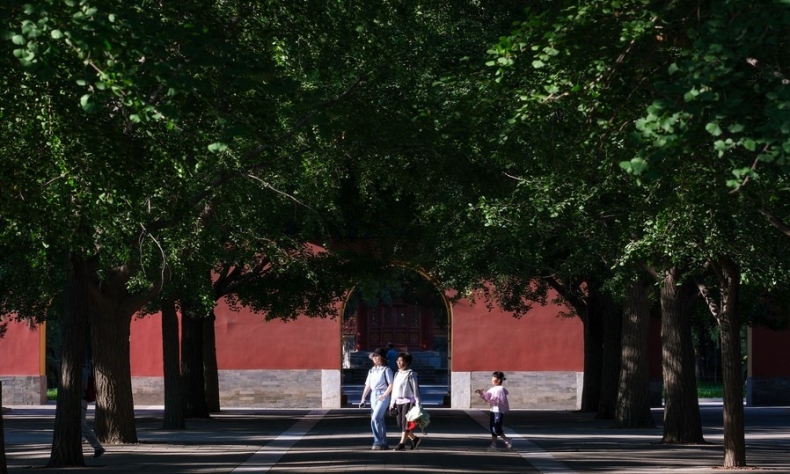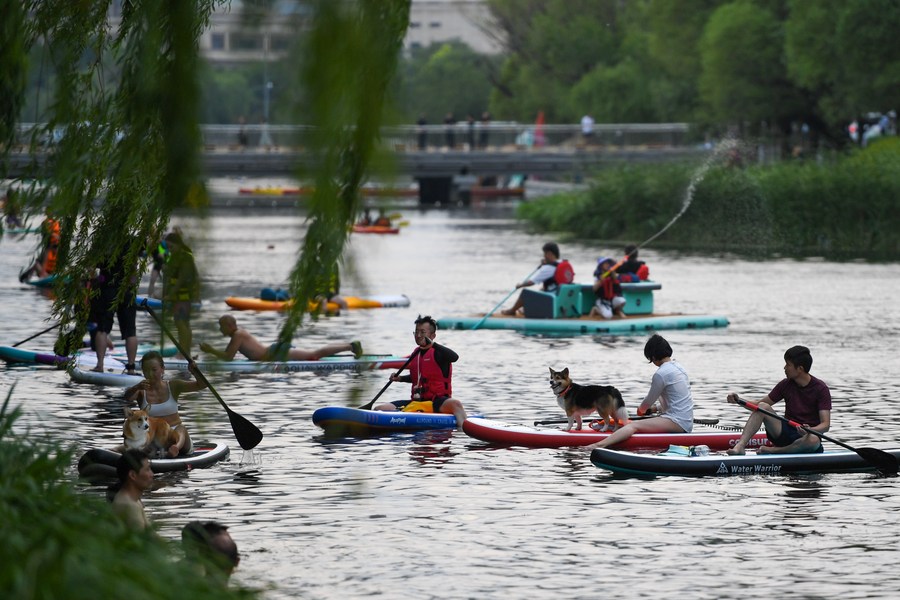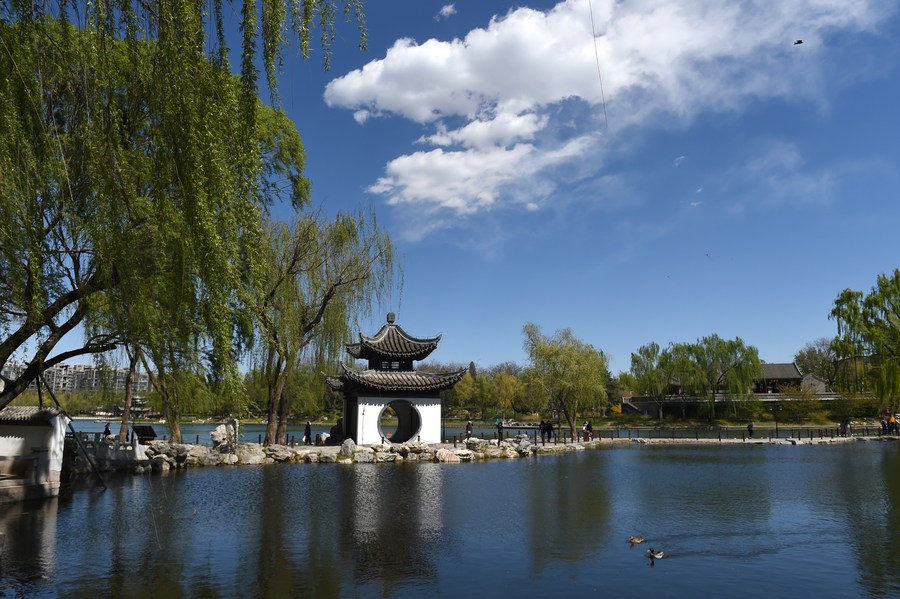A Capital Garden City

A long-term urban development project envisions transforming Beijing into a garden city where people live in harmony with nature.
Chinese President Xi Jinping has planted saplings in Beijing for over a decade, including this year. He has repeatedly said, “We should build Beijing into a beautiful garden city.” Continuing that vision, the Beijing local government released the Beijing Garden City Plan (2023-2035) recently.
“The plan aims to build Beijing into a livable city that pursues harmonious coexistence between humans and nature, and a world-renowned capital that represents the country’s high-quality development and empowers local communities’ engagement in public affairs,” Shi Xiaodong, chief planner of the Beijing Municipal Commission of Planning and Natural Resources, said at a press conference on the Garden City Plan.
Everyone is a gardener
The Chinese civilization has always valued harmony between humans and nature. It is the foundation of both Beijing’s historical sites and new cultural clusters. The plan integrates Beijing’s natural endowments, such as the Taihang and Yanshan mountains, which are the capital’s forest barriers, and five major rivers that run through the city. It has 15 demonstration regions which best represent the essence of Beijing’s landscapes and people. They encompass the old urban residential areas and landmark sites, such as the Badaling Great Wall, National Olympics Sports Center, the Future Science City, and the new Daxing International Airport.
At the same time, the plan highlights the distinct characteristics of the four seasons in Beijing. “We have designed the garden city with four major themes in accordance with the colors of the foliage in Beijing. They are fresh and bright green in spring, lush green in summer, multicolor in autumn, and snow white in winter. Thus, we can create a picturesque city with its mountains, waters, natural scenery, and cultural heritage throughout the whole year,” Shi said. The plan has also designed ecological landscapes for the transportation hubs which connect airports, bus stations, and train stations, so that travelers from all around the world will have an impressive green welcome. The green theme is strengthened by urban greenways where people will live and walk under a green canopy of trees. A greenway network of over 5,000 kilometers has been planned, with urban slow traffic system, greenways, and waterfront spaces. Over 250 boulevards will be afforested to ensure tree shade in the city. Besides, more parks and green spaces will be encouraged to open to the public to facilitate their easier access to green getaways.
Shi said the garden sceneries will be closely connected to people’s life. Therefore, the public will be invited to participate in their construction and share ideas on improving them. The idea is to create an atmosphere where “everyone is a gardener” and “everyone is the owner of the garden city.”
History and hutongs
Ma Qinghong, deputy director of the Beijing Municipal Commission of Housing and Urban-Rural Development, says urban renewal is a key task in the plan. Urban renewal means not only retrofitting buildings but also enhancing urban functions to make the city more livable. The Garden City Plan combines urban renewal with garden city building to create a greener, more livable, and ecological capital for a big country.

The Liangmahe International Style Waterfront Project is an exemplary project. Located in Beijing’s popular Chaoyang District, it maintains the ancient capital’s distinct features with a modern and fashionable lifestyle. Weeping willows and swaying reeds along the Liangmahe River form a beautiful frame around a bay of clear water and a wharf dotted with fountains and cascading waterfalls. This is a thriving leisure destination with its restaurants and cafés teeming with young people, children playing and riding their bikes and others enjoying the scenery. This harmonious picture has been achieved due to the environmental improvements in recent years.
“Green ecology is the top priority in the construction of a garden city,” Ma said. The Liangmahe project started with the transformation and improvement of this urban waterfront area and its green spaces, creating an 18-kilometer waterfront greenway, which provides quality leisure space for the public. The convenient greenway has also become a business cluster for nighttime culture and tourism consumption, boosting the capital’s consumption capability.
Since Beijing is a historical city that has been a cultural center for thousands of years, there is a special stress on preserving its cultural heritage. Li Rugang, deputy director of the Beijing Municipal Commission of Urban Management, said 60 of Beijing’s most beautiful streets and alleys have been spruced up. Last year, 20 routes to explore the most beautiful alleys were created for explorers to experience Beijing’s unique cultural charms.
The 850-meter Dashilan Historical and Cultural District route includes four boutique streets and alleys. It passes through popular intangible cultural heritage sites, including the Daguanlou Cinema, Qing- yunge Pagoda, and the Beijing-Hangzhou Grand Canal. Additionally, visitors can check out the iconic fashion shopping center of Sanlitun in Chaoyang District, and the historical Lugou Bridge near ancient Wanping Town in southwest Beijing.
A major feature of Beijing’s urban construction is the culture of hutongs, traditional alleyways with single-storied residences built around a courtyard. Ma said they have launched “micro gardens” in the alleys, which combine courtyard greening and architecture, preserving the climbing vines, flower pots, and flower racks. The green plantings on walls, or vertical gardens create a refreshing environment.
With the renovation of alleys and courtyards, the historical and cultural characteristics of old Beijing are being showcased with a new vitality.
Parks without borders
A garden city will enhance the diversity, stability, and sustainability of the ecosystem, achieving harmonious coexistence between humans and nature. According to Lian Guozhao, deputy director of the Beijing Municipal Forestry and Parks Bureau, Beijing has over 600 species of terrestrial wild vertebrates, including 519 species of birds, which shows the effectiveness of its biodiversity conservation work.
In addition, the area of forests accounts for 44.9 percent of the capital city’s total area. “By 2025, its forest stock volume will be 34.5 million cubic meters, with an annual carbon sink capacity of 10 million tons,” Lian said.

“Pocket parks,” small and micro green spaces, and “boundless parks” are the new highlights in the construction of the garden city. Lian said by 2035, the per capita green area in parks will reach 17 square meters and over 95 percent of residents will have a green space within a 500-meter radius.
“Boundless parks,” as the name suggests, are parks without fences which are open to the public 24 hours a day, so that the “last 500 meters” on people’s way home are green as well. More than 100 “boundless parks” have been renovated in Haidian and Chaoyang districts.
The Yuan Dadu City Wall Ruins Park is the first boundless park in Beijing. The park was built in 1988 to preserve the walls of ancient Beijing when it was the capital of the Yuan Dynasty (1271-1368). After the fences were dismantled, shrubs were replanted and public facilities built, with the area near the sidewalk tiled and displaying flower windows. The seats at the bus stop there have been designed like a leaf with veins.
Livable waterfront
Ecological protection and water conservation are key in the construction of garden cities. Yang Jinhuai, deputy director of the Beijing Water Authority, said the quality of the water of the Miyun Reservoir in northeast Beijing has always maintained the Class II standard for drinking water resource. Various bird species, such as herons and spotted sand ducks, build their nests and rear their young ones there and the water ecology is improving.
It was recently announced that a cultural and tourism scenic spot will be built in Tongzhou, Beijing’s subcenter, by 2025. It will revolve round the Beijing (Tongzhou) Grand Canal that was a bustling trade and culture route in the past. Visitors can set off from the Canal Culture Square, visit the ancient architectural complex, see the lighthouse and then take a boat southward to the natural oxygen bar – the Grand Canal Forest Park. It is one of the 11 sprawling riverside forest parks in Beijing.
Today, riverside and lakeside spaces have become important public spaces for showcasing urban charm and diverse cultures. Yang said the city’s “green lung,” the Wenyuhe Park, has an area of about 30 square kilometers. It has multiple functions. Besides being a leisure park, it is also an animal and plant conservation and flood storage and detention area. In addition, the park has formed 12 million square meters of flood control areas, improving the flood control capacity of the basin area.
The Garden City Plan promises more waterfront spaces, landscape improvement projects, waterfront walkways, new ice rinks, and areas for kayaking and doing other water sports. By 2035, the length of the river with a waterfront slow traffic system is expected to reach 550 kilometers, creating an urban landscape of a waterfront garden with a blue sky, green scenery, and clear water.
 Facebook
Facebook
 Twitter
Twitter
 Linkedin
Linkedin
 Google +
Google +










